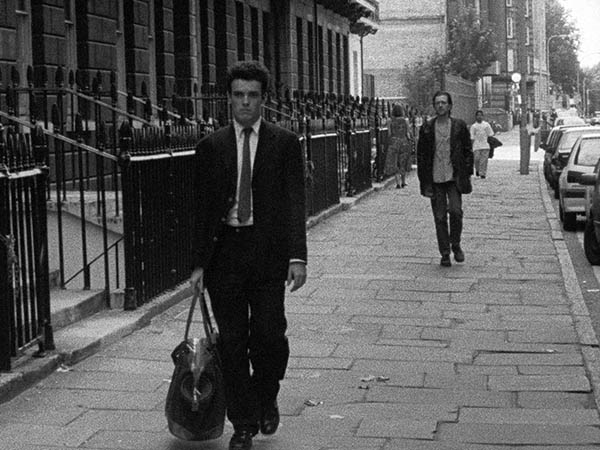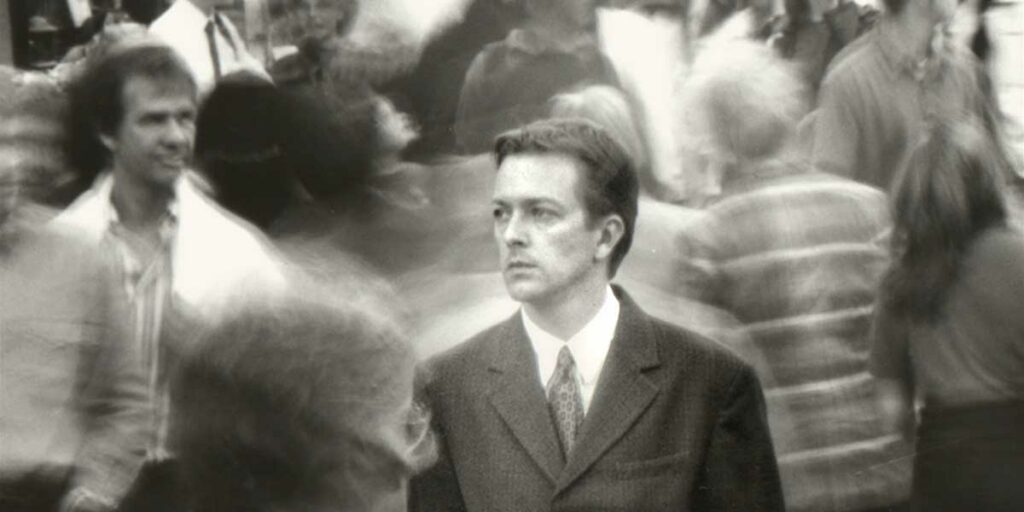Following (1998) is an imperfect, but nonetheless brainy, existential take on film noir, which seems even more impressive considering its limited budget.
David Lynch made Eraserhead, Darren Aronofsky produced Pi, Roman Polanski crafted Knife in the Water, and Christopher Nolan delivered Following. What all these films have in common is that they are debut films of now established masters of cinema that, though all shot in an experimental style and on a budget, now also contain “signature” film styles of their respective directors.
Christopher Nolan’s debut Following introduces a lonely man with writing aspirations, “the Young Man” (Jeremy Theobald), who starts following random people just to know “where they go and what they do”. The Young Man’s “game” leads him to make the acquaintance of serial burglar Cobb (Alex Haw), who recruits him to do a series of eccentric raids on homes. As the partnership between the two men progresses so does the Young Man’s descent into an uncharted territory of voyeuristic deviance and crime, until into the picture comes one young woman, the Blond (Lucy Russell), who becomes more than just the new crime duo’s next victim. Shot in black-and-white and on location, but also on a very strict budget, Following is necessarily unrefined, but it already showed signs of one distinctive cinematic vision and the director’s trademark affinity for complex, non-linear narratives.
Nolan’s inspiration for the film was his residence in the West End area of London in the 1990s and being a victim of burglars himself. It is his fascination with loneliness in a big city and the illusionary boundaries people erect while living so close to each other that prompted him to write Following. In a confined area like central London, with crowds jammed into a tiny space, people necessarily put out certain mental and physical “barriers” against others to ensure their sense of individuality and to protect their privacy. But, who are those “others”? Can one just follow a stranger and see where it leads? What if one breaks down another’s “barrier”?
Following starts just in this intriguing way as the Young Man in the story follows one man dressed in a suit and carrying a bag. That man is Cobb, who soon introduces the Young Man to the thrill of trespassing onto other people’s private space and taking or trashing only the most personal and private of their possessions. These are very unlikely burglary scenarios, but Nolan’s deliberate hand-held camera work gives the story a great sense of realism, while also heightening the secretive nature of the duo’s activity.

Further on, the film follows the usual film noir structure. There is one likeable average Joe (the Young Man) who gets entangled into one extraordinary situation, a web of crime (the burglars), and, in the course of it all, becomes enchanted by one femme fatale (The Blond), who, in turn, happens to be under authority of one older, richer and more powerful man, the owner of a club in our story (Dick Bradsell). The Young Man gets close to the Blond romantically, but does not even realise the ingenuity of the traps that awaits him as the Blond’s flat becomes just another one in a series of his and Cobb’s seemingly senseless burglaries.
Classic noir films, including Double Indemnity, Laura and Out of the Past, all have variations on this story, but though Nolan may have been influenced by those, as well as by the work of Alfred Hitchcock, his scenario also has certain connections with European satirical noir thrillers, especially those penned by Frédéric Dard (The King of Fools). This is especially so since Following appears to have some irony and even situational humour.
But, while it is usual for a film noir to use flashbacks to tell a story, Nolan goes a step further and employs a totally non-linear narrative, and we even at times see his film “in reverse,” with later film chapters being showed to us at the beginning. These do not initially make much sense, but will be clarified as the story unfolds. Nolan’s use of the non-linear format may appear quite original, but many films in the past employed the same techniques (notably Tarantino’s Pulp Fiction, made just three years prior), and in fact, Following is not even the top film of 1998 to employ such techniques, as, that year, both experimental thriller Run Lola Run and romantic comedy Sliding Doors (inspired by Polish film Blind Chance) used the same non-linear story format. Incidentally, Sliding Doors, starring Gwyneth Paltrow, even has the same idea as Following to change the main character’s appearance so drastically that the audience knows immediately what time-line they are being shown.
Moreover, there is further dimension to Following, and that is a thought-provoking imbalance in power dynamics. The shy, dreamy and fidgety rookie (the Young Man) is becoming an apprentice to the dominant, confident, practical and suave “alpha male” (foil Cobb) who shows his new pupil the ropes. The two men’s identities and goals get a little mixed in the process, and the Young Man in Following also tries to transform himself to be more like Cobb. And, if that sounds familiar, then it is because Chuck Palahniuk’s novel “Fight Club” was published only two years before Following’s release. Nolan’s emphasis throughout the film on this through-provoking relationship between the two contrasting men is so winning that it even at times recalls what is arguably the best example of such relationship in British cinema – Joseph Losey’s film The Servant, where the battle of wits is between two very different men (one poor and one wealthy).
Jeremy Theobald, Alex Haw and Lucy Russell all do a good job in their respective roles in the film,but nothing remarkable, and that is perhaps because their characters are “fixed” and do not develop much with the script. And, clocking in at just over one hour, Following is not a long film, but neither does it feel sketchy. As counter-intuitive as it may sound, but creativity does flourish under restraint. Without the use of expensive locations, much time or special effects, Nolan’s only bet for success for this film was his ability to construct a complex, but intelligible plot, nuanced characterisations, as well as pay special attention to camera positions and details.
Nolan succeeded – he probably could not afford to do otherwise. And, as the director confesses in his recorded commentary to the film, it is the attention to objects in the story which is very important, and some objects do play pivotal roles in Following. They are the story’s foundation blocks that show transitions between different narratives, but they also function as important points aiding realisations and anticipating twists. In that way, they are now not that dissimilar to David Lynch’s use of certain objects, such as a key, a box and an espresso in Mulholland Drive or Nolan’s own focus on one totem in Inception. So, in Following, one misplaced earring and the Blond’s cherished box of mementos gain immense significance.
Beyond the Batman franchise, the key word for Christopher Nolan’s filmography may be “labyrinthine”. So far, the director has explored the memory, dream, and time “labyrinths” (Memento, Inception and Tenet respectively), to name just a few, and in his feature debut, there was a presentation of a curious labyrinth of strangers’ apartments, the urban maze of false appearances and deceit to which our main protagonist was pushed by both loneliness and curiosity.
With time jumping back and forth in Following, the audience may get a little lost in Nolan’s first built narrative labyrinth, but that is also where the thrill and awe come in, with the director wanting the viewer to take a second look at his architectural wonder and long for that time when they can re-watch the film so that they can finally connect all the dots. With its intelligent story and that impressive double twist near the end, Following is a memorable debut, and the hope is that Nolan, after his series of blockbusters and biographical epics, would make at least one other return to this quieter, but no less effective mode of film-making.
Following is now available to watch on digital and on demand. Watch Following!

